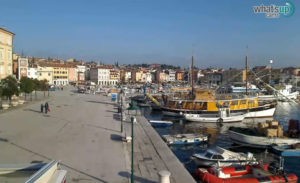Description
Live Web Cam - Kamere uživo iz Hrvatske - Web Kamere Uživo - Web Cam in diretta - Web Cam Live - Web Cam in Croatia - Webcam in Kroatien - Webcam in Croazia
Rovinj - Live Cam Croatia - Web Kamera uživo iz Hrvatske - Panorama - Web Cam - Weather Cam
Rovinj (pronounced [rǒʋiːɲ]; Istriot: Ruvèigno or Ruveîgno; Italian: Rovigno, Ancient greek: Ryginion, Ρυγίνιον) is a city in Croatia situated on the north Adriatic Sea with a population of 14,294 (as of 2011). Located on the western coast of the Istrian peninsula, it is a popular tourist resort and an active fishing port. Istriot, a Romance language once widely spoken in this part of Istria, is still spoken by some of the residents.
Geography
Rovinj is one of nine settlements officially designated as towns in Istria County in western Croatia. It has a Mediterranean climate, with the average temperature 4.8 °C (40.6 °F) in January and 22.3 °C (72.1 °F) in July. The average annual temperature is 16 °C (60.8 °F). Sea temperature is more than 20 °C (68 °F) from the mid-June to September. The average annual sea temperature is 16.6 °C (61.9 °F).
From May to September the Rovinj receives more than 10 sunshine hours a day. The rainfall averages 941 mm (37.05 in) a year and average air humidity is 72 percent. Vegetation is subtropical.
Originally the peninsula on which the city lies was an island, separated from the mainland by a channel. The latter was filled in 1763. Rovinj Archipelago includes 22 islets.
History
Rovinj was already a settlement of Illyrian tribes before being captured by the Romans, who called it Arupinium or Mons Rubineus, and later Ruginium and Ruvinium. Built on an island close to the coast, it became connected to the mainland much later, in 1763, by filling in the channel.[3]
Rovinj was eventually incorporated into the Byzantine Empire, later becoming part of the Exarchate of Ravenna in the 6th century, before being taken over by the Frankish Empire in 788. For the following several centuries it was ruled by a succession of feudal lords, and in 1209 it was acquired by the Patriarchate of Aquileia under Wolfger von Erla.
From 1283 to 1797 Rovinj was one of the most important towns in Istria governed by the Republic of Venice. During this period three town gates were constructed and Rovinj was fortified by two rows of defensive walls, remains of which can still be seen today. Nearby the Rovinj pier one can find one of the old town gates, the Balbi's Arch, dating from 1680, and a late-Renaissance clock tower. The first city statute was proclaimed in 1531.
Following the fall of Venice in 1797 and the ensuing Napoleonic interlude, Rovinj became part of the Austrian Empire, which lasted until World War I. According to the last Austrian census in 1911, 97.8% of the population was Italian-speaking. It then belonged to Kingdom of Italy from 1918 to 1947, when it was ceded to SFR Yugoslavia, as part of SR Croatia. During the post-war period many Italian inhabitants left Rovinj, which led to significant changes to Rovinj's demographic structure.
Following Croatia's independence in 1991, the town became one of the most important centers of Istria County, an administrative unit encompassing most of Istria. Rovinj is today the third most populous town in the county, behind Pula and Poreč.
Population
| Historical populations of Rovinj | ||
|---|---|---|
| Year | Pop. | ±% |
| 1880 | 10,100 | — |
| 1890 | 10,354 | +2.5% |
| 1900 | 11,042 | +6.6% |
| 1910 | 13,160 | +19.2% |
| 1921 | 10,863 | −17.5% |
| 1931 | 11,069 | +1.9% |
| 1948 | 8,589 | −22.4% |
| 1953 | 6,374 | −25.8% |
| 1961 | 7,818 | +22.7% |
| 1971 | 9,464 | +21.1% |
| 1981 | 11,861 | +25.3% |
| 1991 | 13,559 | +14.3% |
| 2001 | 14,234 | +5.0% |
| 2011 | 14,294 | +0.4% |
| Source: Naselja i stanovništvo Republike Hrvatske 1857–2001, DZS, Zagreb, 2005 | ||
In 2007 there were 13,562 people living in Rovinj. 76.31% are Croats, while ethnic minorities include Italians (16%), Serbs (3.51%), Albanians (2.37%) and Bosniaks (1.81%).[citation needed]
City government
The City Assembly is composed of 19 representatives, coming from the following political parties:
- Istrian Democratic Assembly (IDS) 13
- Independent 3
- Social Democratic Party of Croatia (SDP) 2
- Croatian Democratic Union (HDZ) 1
Economy
The main economic activity in Rovinj is tourism and during peak season (May–September), its bars, restaurants and art galleries work long hours, while operating limited hours off-season.
The busiest area is the very centre of Rovinj, extending from the main bus station towards the old part of town, where most bars and clubs are located.
The town's main central thoroughfare is the fully pedestrian Carrera Street, with many independent shops and art galleries. A farmer's market is located at the edge of the historic part of town, near Valdibora Square.
According to data compiled by Istria Tourist Board, Rovinj is the second biggest tourist destination in the county, in terms of overnight stays. The two closest airports are Pula (Croatia) and Trieste (Italy) and during the summer season, low-cost airlines such as Ryanair operate direct flights from western Europe to both airports. Also during the summer season, there is a direct high speed ferry link between Venice and Rovinj. High speed weekly lines to the Port of Ravenna and Cesenatico are also available in the summer.
There are numerous hotels in the town itself, and beds are abundant though usually overbooked in the summer months. Accommodation ranges from private rooms or apartments to bungalows, camping sites and 2 to 4 star hotels. The city also has two luxury, 5-star boutique hotels, Hotel Monte Mulini and Hotel Lone. Apart from hotels on the mainland, there are also a handful of hotels on small islands surrounding Rovinj which are linked to the mainland by boats which go from the city centre to the hotel on the islands.
Sights and landmarks
- St. Euphemia's Basilica
- Monkodonja
- Zlatni Rt Forest Park
- The Rovinj islands and mainland. These natural sights have been described as "outstanding scenic wonders," because of the pristine beauty of the indented coastline and its forests, consisting of holm oak and Alpine pine trees. This area "of outstanding natural beauty" extends from St. Ivan promontory to Barbariga, including all the Rovinj islands and the mainland 500 metres from the shore line. The Rovinj archipelago consists of 19 islands.
- Limska Draga Fjord
- The Palud marsh and the Dvije Sestrice Islands - The Dvije Sestrice (Two Sisters) islands are a nesting site for seagulls. Because of its thick holm oak forest the Gustinja promontory is regarded as "a forest vegetation reserve."
- Rovinj Town Museum
Transportation
The preferred means of transport for getting around Rovinj is by car. Rovinj is well-connected with the rest of Istria and with larger cities in the region such as Trieste, Rijeka, Ljubljana and Zagreb.
The centre of Rovinj, which includes the old town, is very walkable and transportation by bike or scooter is a preferred means of getting around for many locals.
The closest commercial international airports are Pula (20 miles), Trieste-Ronchi (70 miles) and Rijeka-Krk (80 miles). Car rental is available at each of the airports.
Rovinj is served by the Kanfanar railway station (10 miles), which connects the region to Rijeka. However, travelling by bus is preferred to travelling by train due to the limited connections and schedules. The main bus station is located at the south-east end of Carrera Street.
Live Web Cam - Kamere uživo iz Hrvatske - Web Kamere Uživo - Web Cam in diretta - Web Cam Live - Web Cam in Croatia - Webcam in Kroatien - Webcam in Croazia
Location
, Rovinj, Croatia






Add a review